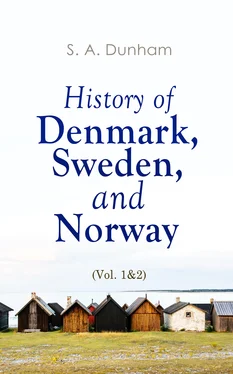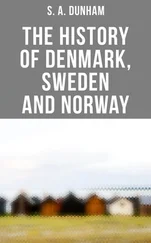|863.|
Halfdan the Black was, for his age, a superior prince. He made some laws, and, what is much better, he caused them to be observed. His legislation, of course, was truly Gothic; that is, crimes were visited with pecuniary mulcts, varied according to the rank of the culprit and of the person injured. He was not so fond of his youthful son Harald as was the mother, Ragnilda; yet the qualities of the boy were such as to excite the admiration of an heroic age. The death of this king was, in the superstitious opinion of the times, preceded by a wonderful circumstance. As he was sitting at table with a multitude of guests, to celebrate the yule festival, the meats and drinks suddenly disappeared. The latter, alarmed at the portent, quitted the table, and left the king alone. What could be the meaning? A Finnish magician was seized, put to the torture, and commanded to say what the portent indicated. But he could or would say nothing; and he besought prince Harald to procure his liberation. Harald applied to the king; but finding him inexorable, he allowed the poor Finn to escape, and was the companion of his flight. At this time, Harald was only ten years of age; and he was to see his father no more. Immediately after this event Halfdan returned, on a sledge, towards another part of his dominions. In his way was a lake, which was to be crossed over the ice. But holes had been made in it, for the cattle to be watered; a thaw had commenced, and the king had not proceeded far before the ice gave way, and he was engulfed in the cold abyss; most of his attendants perishing with him. Thus ended the short but memorable career of Halfdan the Black. His memory was always dear to Norway; and during his life he was always reverenced as one of the greatest benefactors of his people. A prodigious crowd arrived to honour his funeral; but they would not allow the body to be interred in Raumarik. During his reign the land had been so fertile that he was believed to be an especial favourite of the gods. Wherever he was, dead or alive, prosperity was expected; and the warriors from the different states of his kingdom demanded that he should be buried in their district. The dispute, we are told, was ended by the division of his body into four parts, corresponding with the four shires of Raumarik, Ringarik, Hedmark, and Westfold. The head was buried in Ringarik, the other members in each of the other districts. Hence, says the historian, the number of sepulchres which are still called the tombs of Halfdan. [168]
|863.|
As Harald Harfager was but a child when his father was drowned, the neighbouring reguli, under the pretext of recovering what their predecessors had lost, hastened to divide his ample inheritance. One party invaded Hedmark, a second Westfold, a third advanced towards the residence of Harald, to make him prisoner. But he had a noble defender in his uncle, Guthrum [169], whom he made general of his troops, and his minister. This chief collected troops, and, with the young king, marched against the invader of Westfold, whom he defeated and left dead in the field. The place where this great victory was achieved was called Hakadal , or Hako’s Dale, from the name of the chief who fell there. Another invader of that province, Gandulf, was defeated; but, more fortunate than Hako, he contrived to escape with life. Seeing the fate of these two battles, the remaining princes determined not to fight singly, but in concert; and a meeting was appointed in the rock mountains of the upland province of Hedmark. But the intention was soon known to the two heroes; and, proceeding, without loss of time, to the appointed place, they fell, at midnight, on the outposts of the camp, while two of the chiefs were sleeping, and in the skirmish which ensued, sent two other kings to join them in the hall of Odin. The fruits of this victory were not only the recovery of all which had been invaded, but the acquisition of several districts to the north and west of his hereditary possessions. When Gandulf returned to the charge, he was again defeated, and sent to drink mead, to feed on the grisly boar, and to fight with the dark shades of Odin’s warrior ghosts: his dominions as far as the river Raum became the prize of the victor. [170]
|865 to 868.|
After these unexpected successes, Harald thought that he might aspire to the favours of any princess in the north. Hearing of the charms of Gyda, daughter of Eric, jarl or king of Hordaland, he sent messengers to her, not with the offer of his hand, but of his heart. The reply of the lady, if any faith is to be reposed in tradition, was unequalled for its pride. So far from being the mistress, she would not be the wife, of one whose territory consisted in a few insignificant provinces; she would never marry any one beneath the dignity of a monarch—who did not, like Eric of Sweden, and Gorm of Denmark, hold absolute sway over the whole country. The answer of the heroine being brought to the king, he admired her ambition, and vowed to the gods that he would never cut or comb his hair until he had subdued the whole of Norway—until its revenues and authority were his: and if he failed in his attempt, the penalty should be his life. All this is fable: Harald needed not a woman’s advice to enter on a career which he had long meditated, and which his father had, probably, meditated before him. He might, however, make the vow. In pursuance of that vow, which was highly pleasing to Guthrum, he enlisted all the forces he could, and marched towards the north, through Godbrandsdalia, having the Dofrafeld mountains on his left. The inhabitants fled at his approach into the uplands; some into Orkadal, others into Ganlardal, others into the recesses of the mountains; but many—perhaps the greater number—preferred his yoke to exile and ruin: they did homage, and were unmolested. Pursuing his way into Orkadal, which lay beyond the Dofrafeld chain, in the modern province of Drontheim, he defeated an army, there assembled to oppose him, received the homage of the royal general, and annexed Orkadal, as he had done the intervening regions, to the other dependencies of his crown. Nor must it be forgotten that he was the great champion of the feudal system. Wherever he conquered, he abolished the allodial law of inheritance, and converted all lands into fiefs, to be held from him alone, on the usual obligations. But he did more: he insisted that all rents should be paid in kind; that one third of the portion accruing to the crown should be set apart for the support of the local government. Over each province he placed a jarl, whose duties were, to defend it against all enemies, to collect the revenues, to preside over the local administration. Associated with each jarl were four, at least two, herser or councillors, whose office was at once military and administrative; and to each was awarded a benefice of twenty marks in yearly value. In time of war each jarl was to support sixty, each of the herser twenty, armed men, at his own expense. So ample were the revenues of each province, that the jarls were more wealthy and more powerful than many royal chiefs of the period. Hence the dignity was an object of ambition, and he who could bestow it did not want applicants for it: in the hope of obtaining it, most of the nobles hastened to join him whenever he entered a province. [171]
Конец ознакомительного фрагмента.
Текст предоставлен ООО «ЛитРес».
Прочитайте эту книгу целиком, купив полную легальную версию на ЛитРес.
Безопасно оплатить книгу можно банковской картой Visa, MasterCard, Maestro, со счета мобильного телефона, с платежного терминала, в салоне МТС или Связной, через PayPal, WebMoney, Яндекс.Деньги, QIWI Кошелек, бонусными картами или другим удобным Вам способом.












